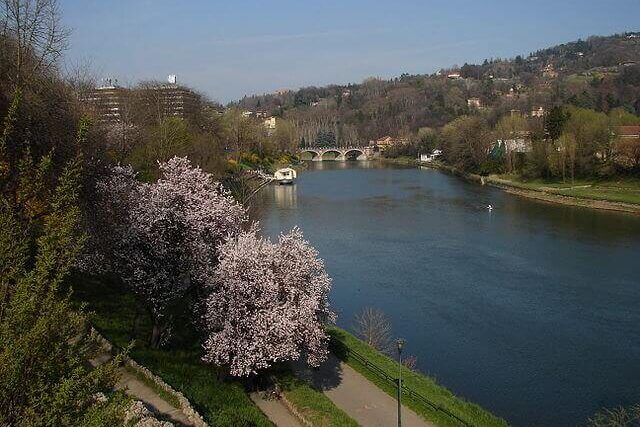
After little snow or rain this winter, Italy is in for another severe drought year.
There are concerns for farming, hydropower, and drinking water in vast areas along the Po River that are already dry.
After a winter with little rain and snow, Italy’s rivers and lakes are facing another year of severe drought. This has serious implications for farming, hydropower, and drinking water access.
The country’s longest river, the Po, which feeds several northern and central regions, is already severely depleted, and Lake Garda is experiencing its lowest winter water level in 35 years.
Venice’s canals have dried up due to unusually low water levels, leaving gondolas stranded.
According to the National Research Council (CNR) of Italy, rainfall in the north decreased by 40% in 2022, and there had been a significant lack of precipitation since the beginning of 2023.
Specifically, the Po, which originates in the north-west from the Alps and travels through the Po delta before reaching the Adriatic, faces a repeat of the worst drought in seven decades unless rain arrives in the spring. The riverbanks in the Pavia region of the Po valley are transformed into beaches when the water level drops 3 meters below the zero mark, a typical summertime occurrence.
“Nothing has changed since 2022,” said Luca Mercalli, the president of the Italian Meteorological Society. “We are still in a situation of deficit … let’s wait for the spring, which is usually the rainiest period for the Po valley. There is a good possibility that rainfall in April and May can compensate – it’s the last hope. If we have no spring rain for two consecutive years then it would be the first time this has ever happened.”
The Po also passes through one of Europe’s most important agricultural regions, Veneto, and Emilia-Romagna. The valley experienced droughts in 2007, 2012, and 2017 as well as a prolonged heatwave in 2022. Scientists believe that the valley’s increasing prevalence is another sign of the climate crisis.
According to Coldiretti, Italy’s largest farmers’ association, agricultural produce suffered damage worth €6 billion (£5.4 billion) during the 2022 drought. It warned that unless another prolonged and severe drought was avoided, a third of production would be at risk this year.
The Po basin authority’s president, Alessandro Bratti, stated that the situation was most severe in Piedmont and Lombardy, while it was affecting the production of hydroelectric power in Trentino.
“If you have no water you cannot produce energy, so this is another problem,” Bratti said. “It is very critical because it hasn’t snowed or rained during this period and the forecast says it will stay this way.”
Seawater encroaches further up the river, filling aquifers and rendering them unusable for irrigating farmland due to the Po’s low level.
“Last year sea water entered for almost 40km [25 miles], which also causes a problem for drinking water as you need to use desalinators,” said Bratti.
In order to assist drought-affected regions, the Italian government, which at the time was led by Mario Draghi, released €36.5 million last summer. Additionally, the move enabled local authorities to take immediate action, such as imposing water rationing measures, without having to deal with the usual bureaucracy.
Although the Po basin authority was in charge of coordinating the measures, its only authority is to provide advice, such as recommending ways farmers can save water.
“There are many entities involved and the protocol at the moment is voluntary,” said Bratti. “There needs to be a law that gives the basin authority the power to work out the problem and decide what to do – it could be telling farmers to stop drawing water for a month or stopping hydroelectric power for a week.”
He stated that the Draghi administration’s funds were still in place, but that drought-related projects had been slow to move forward since the new government led by Giorgia Meloni took office in October.
“We have projects and funds for hydrological infrastructure, such as building barriers to prevent the sea from entering the river,” Bratti added. “There is also a proposal to build 10,000 lakes, and to introduce technical systems to cut down the waste of water in farming. We now need to accelerate the projects.”
——————————————————————————
At Natural World Fund, we are passionate about stopping the decline in our wildlife.
The declines in our wildlife is shocking and frightening. Without much more support, many of the animals we know and love will continue in their declines towards extinction.
When you help to restore a patch of degraded land through rewilding to forests, meadows, or wetlands, you have a massive impact on the biodiversity at a local level. You give animals a home and food that they otherwise would not have had, and it has a positive snowball effect for the food chain.
We are convinced that this is much better for the UK than growing lots of fast-growing coniferous trees, solely to remove carbon, that don’t actually help our animals to thrive.
This is why we stand for restoring nature in the UK through responsible rewilding. For us, it is the right thing to do. Let’s do what’s right for nature!
Support our work today at https://naturalworldfund.com/ and join in the solution!

